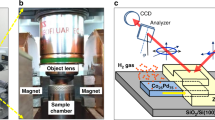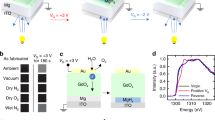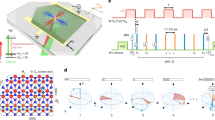Abstract
Switchable mirrors1,2,3 made of thin films of the hydrides of yttrium (YHx), lanthanum (LaHx) or rare-earth metals exhibit spectacular changes in their optical properties as x is varied from 0 to 3. For example, α-YHx <0.23 is a shiny, hexagonally close-packed metal, β-YH2±δ is a face-centred cubic metal with a blue tint in reflection and a small transparency window at red wavelengths, whereas hexagonally close-packed γ-YHx >2.85 is a yellowish transparent semiconductor. Here we show that this concentration dependence of the optical properties, coupled with the high mobility of hydrogen in metals, offers the possibility of real-time visual observation of hydrogen migration in solids. We explore changes in the optical properties of yttrium films in which hydrogen diffuses laterally owing to a large concentration gradient. The optical transmission profiles along the length of the film vary in such a way as to show that the formation of the various hydride phases is diffusion-controlled. We can also induce electromigration of hydrogen, which diffuses towards the anode when a current flows through the film. Consequently, hydrogen in insulating YH3−δ behaves as a negative ion, in agreement with recent strong-electron-correlation theories4,5. This ability to manipulate the hydrogen distribution (and thus the optical properties) electrically might be useful for practical applications of these switchable mirrors.
This is a preview of subscription content, access via your institution
Access options
Subscribe to this journal
Receive 51 print issues and online access
$199.00 per year
only $3.90 per issue
Buy this article
- Purchase on Springer Link
- Instant access to full article PDF
Prices may be subject to local taxes which are calculated during checkout




Similar content being viewed by others
References
Huiberts, J. N. et al. Yttrium and lanthanum hydride films with switchable optical properties. Nature 380, 231 (1996).
Huiberts, J. N. et al. Synthesis of yttrium trihydride films for ex-situ measurements. J. Alloys Compounds 239, 158 (1996).
Griessen, R. et al. Yttrium and lanthanum hydride films with switchable optical properties. J. Alloys Compounds 253–254;, 44 (1997).
Ng, K. K., Zhang, F. C., Anisimov, V. I. & Rice, T. M. Electronic structure of lanthanum hydrides with switchable optical properties. Phys. Rev. Lett. 78, 1311 (1997).
Eder, R., Pen, H. A. & Sawatzky, G. A. Kondo-lattice-like effects of hydrogen in transition metals. Phys. Rev. B 56, 10115 (1997).
Völkl, J. & Alefeld, G. Diffusion of hydrogen in metals. Topics Appl. Phys. 28, 321 (1978).
Fukai, Y. & Sugimoto, H. Diffusion of hydrogen in metals. Adv. Phys. 34, 263 (1985).
Qi, Zh., Volkl, J., Lässer, R. & Wenzl, H. Tritium diffusion in V, Nb and Ta. J. Phys. F 13, 2053 (1983).
Vajda, P. in Handbook on the Physics and Chemistry of Rare Earths Ch. 20 (eds Gschneider, K. A. & Eyring, L.) 207–291 (Elsevier, Amsterdam, (1995)).
Kremers, M. et al. Optical transmission spectroscopy of switchable yttrium hydride films. Phys. Rev. B 57, 4943 (1998).
Boltzmann, L. Zur Integration der Diffusionsgleichung bei variabeln Diffusionscoefficienten. Weid. Ann. 53, 959 (1894).
Crank, J. The Mathematics of Diffusion 105–106 & 230–232 (Clarendon, Oxford, (1975)).
Kidson, G. V. Some aspects of the growth of diffusion layers in binary systems. J. Nucl. Mater. 3, 21 (1961).
Adda, Y. & Philibert, J. La Diffusion dans les Solides 614–621 (Inst. Nat. des Sciences et Techniques Nucléaires, Saclay, (1966).
Tu, K.-N., Mayer, K.-N. J. W. FeldmanL. C. Electronic Thin Film Science 294–324 (Macmillan, New York, (1992)).
Weaver, H. T. Nuclear magnetic resonance study of hydrogen diffusion in yttrium trihydride. J. Chem. Phys. 56, 3193 (1972).
van Ek, J. & Lodder, A. Electromigration of hydrogen in metals: theory and experiment.In Defect and Diffusion Forum Vols 115 116,, 1 (1994).
Zhang, F. C. & Rice, T. M. Effective hamiltonian for the superconducting Cu oxides. Phys. Rev. B 37, 3759 (1988).
Griessen, R. Schaltbare Spiegel aus Metallhydriden. Phys. Bl. 53, 1207 (1997).
Verbruggen, A. H., Griessen, R., Rector, J. H. Hall voltage induced by hydrogen diffusion in palladium. Phys. Rev. Lett. 52, 1625 (1984).
Brouwer, R. C. & Griessen, R. Electromigration of hydrogen in alloys. Evidence of unscreened proton behavior. Phys. Rev. Lett. 62, 1760 (1989).
van der Sluis, P., Ouwerkerk, M. & Duine, P. A. Optical switches based on magnesium lanthanide alloy hydrides. Appl. Phys. Lett. 70, 3356 (1997).
Acknowledgements
We thank B. Hjörvarsson, E. S. Kooij, M. W. J. Prins, P. van der Sluis, M. Ouwerkerk, P. H. L. Notten and P. J. Kelly for discussions. This work is part of the research programme of the Stichting voor Fundamenteel Onderzoek der Materie (FOM), which is supported by NWO; it was also supported in part by the European Commission through the TMR programme.
Author information
Authors and Affiliations
Corresponding author
Rights and permissions
About this article
Cite this article
den Broeder, F., van der Molen, S., Kremers, M. et al. Visualization of hydrogen migration in solids using switchable mirrors. Nature 394, 656–658 (1998). https://doi.org/10.1038/29250
Received:
Accepted:
Issue Date:
DOI: https://doi.org/10.1038/29250
Comments
By submitting a comment you agree to abide by our Terms and Community Guidelines. If you find something abusive or that does not comply with our terms or guidelines please flag it as inappropriate.



